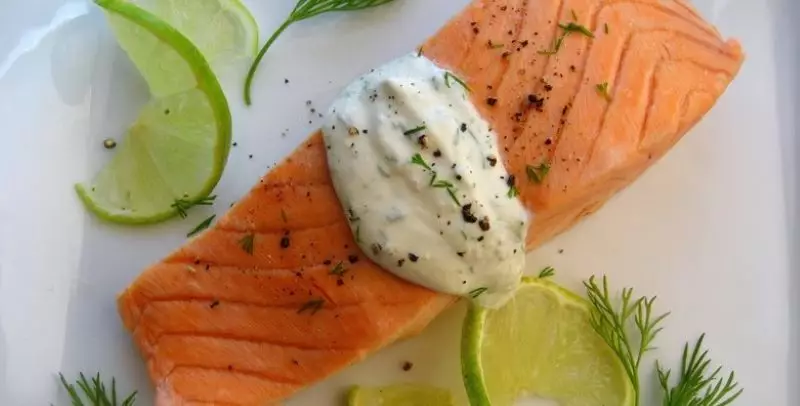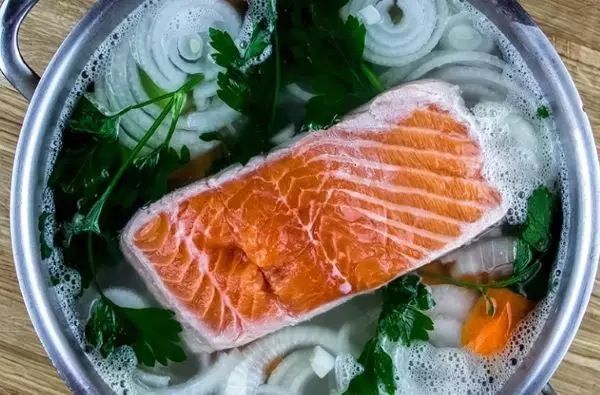
Poached Salmon with Lemon Dill Sauce
Aside from being healthy, salmon is a flavorful fish that offers many ways to enjoy it. This poached salmon with lemon dill sauce recipe is one example of how versatile this fish can be. It allows you to enjoy the natural flavors of the fish, with a light and beautiful texture, while enhancing it with a delicious yet easy sauce.
Table of Contents
Benefits of Poaching Salmon
There are many cooking methods available for salmon; that is how versatile this fish is! So, why should you consider poaching salmon? Is it good for you?
Poaching salmon offers numerous health benefits, such as the following.
1. Preserving the Flavor and Nutrients
The main advantage to poaching salmon is the capacity of keeping the nutritional elements intact. Other cooking methods tend to drain away the nutrients during the cooking process, especially those that involve high heat. Poaching salmon requires gentle simmering in liquid or a heated water vapor, which retains the important nutrients within the fish.
You know when your salmon is perfectly poached because the meat remains vibrant pink. The texture is also rich and flaky. When the fish is overcooked, it becomes tough and hard to chew. The color is also paler instead of a rich pink.
2. Low-Fat Cooking Method
As mentioned, poaching involves cooking the fish in liquid instead of using a cooking oil. It is a healthier alternative than using oil or butter to cook the salmon. You can enjoy the natural flavor of salmon without adding unnecessary calories.
3. Improved Texture
Poaching delivers a beautiful texture to the salmon, which retains the juiciness of the salmon meat. This result is due to the controlled heat when poaching, resulting in a melt-in-your-mouth texture.
4. Easy to Prepare
Poaching does not require advanced culinary skills. It is so simple that even beginners can do it.

How to Poach the Perfect Salmon
Do you want to achieve perfectly poached salmon every time? Most people are intimidated by the idea of poaching salmon, thinking that it is a complex method. In reality, poaching is a simple process.
First, take note that not all fish are suited for poaching. It is ideal for lean fish, such as cod, tilapia, and flounder, as well as fatty fish, like salmon.
When poaching, make sure that the liquid fully covers the fish. And keep it at a gentle simmer. You know when the fish is cooked when its internal temperature reaches 140F. Therefore, keep your water temperature within that range until the fish meat has turned translucent.
The great thing about poaching is that you won’t run the risk of overcooking the fish, even if it stays in the liquid a bit longer than recommended.
Here are additional tips to get perfectly poached salmon.
- For the best tasting poached salmon, invest in a flavorful stock. Instead of using water, you can use chicken broth to enhance the flavor. If you don’t have chicken broth, you can add seasoning and fresh herbs to add flavor to the stock. Poaching the fish in a flavored stock allows the fish to soak in those flavors.
- Again, make sure that the fish is fully covered in liquid. If some parts of the salmon are not soaked in water, it results in an inconsistent flavor and texture.
- Keep a close eye on the salmon while poaching it. Use a thermometer to monitor and maintain the consistency of the poaching liquid.

Poached Salmon with Lemon Dill Sauce Ingredients
- 8 salmon fillets
- 2 cups water or chicken broth
- 1 onion, thinly sliced
- 4 sprigs of fresh parsley
- 4 slices of lemon
- Salt
- Ground black pepper
For the sauce:
- 2 tbsp butter
- 2 tbsp all-purpose flour
- 4 tsp finely chopped fresh dill
- 1 tsp white sugar
- 1 tsp salt
- 2 egg yolks (large), beaten lightly
- 2 tsp lemon juice
How to Make Poached Salmon with Lemon Dill Sauce
Step 1: Rinse salmon and dry it with a towel.
Step 2: In a large skillet, combine the chicken broth or water with onion, lemon, parsley, salt, and pepper.
Place the salmon into the skillet in a single layer. Once the water is close to the boil, reduce the heat and leave it to simmer gently.
After five or 10 minutes, check on the salmon. Remove it from the skillet and keep warm.
Step 3: Strain the liquid and reserve the water.
Step 4: In a small saucepan, melt the butter over medium heat. Add the flour, dill, sugar, and salt. Wait for the mixture to bubble before adding the cooking liquid you set aside earlier. Continue whisking the mixture until the sauce thickens.
Step 5: Scoop half a cup of the sauce into the egg yolk mixture and make sure they are fully incorporated. Add the mixture back into the saucepan and cook for a minute or two. Stir in the lemon juice.
Step 6: Scoop the sauce and spread it over the salmon when serving. You can serve the rest of the sauce alongside the salmon.
Other Poaching Recipes to Try
Poached salmon is popular because of its versatility, flavor, and nutritional profile. However, you have more options of fish to try if you want to use the poaching method of cooking.
This cooking technique works best on lean fish, such as haddock, flounder, cod, and tilapia. It also works best for meaty and fatty fish, such as salmon.
If you’re not a fish fan, you can try the poaching method with other ingredients, such as egg, chicken, seafood, and fruits. For example, poached chicken breast is a popular choice for poaching because it creates a tender, juicy result. The poached chicken breast can be enjoyed on its own, or shredded before it is served in a salad or sandwich.
Another great recipe to try is poached lobster with herbs. It is an easy yet delicious way to serve lobster and achieve perfectly succulent seafood meat.
What to Serve with Poached Salmon
There is an endless array of ideas on what to serve with poached salmon with lemon dill sauce. A staple choice is to serve it with garlic sauteed spinach, cucumber salad, sauteed green beans, and roasted butternut squash.
If you prefer it, you can also serve poached salmon with quinoa or rice.
Discover Other ChefsTemp Products
Discover more recipes and learn kitchen tricks by joining our cooking family on Facebook.
You may also like:















